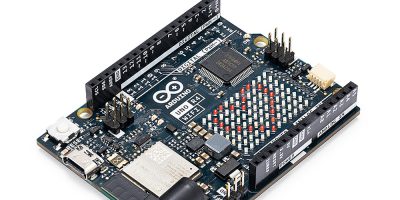Arduino Uno Wi-Fi variant is powered by 32bit microcontroller
Open source hardware and software provider, Arduino, has announced next generation Uno board, describing it as “a significant revision of its 8bit technology”. The Uno R4 is powered by a 32bit microcontroller and is available in a basic (Uno Ra4 Minima) and a comprehensive Uno R4 (WiFi) for different budget and creative levels of the maker community.
The Uno R4 has the same standard form factor, shield compatibility and 5V power supply of the Uno R3, with the addition of a 32bit microcontroller with up to 16x the clock speed, memory and flash storage with the integration of the RA4M1 processor from Renesas.
The RA4M1 microcontroller is based on an Arm Cortex-M4 core and features a clock speed of 48MHz for higher processing power. To accommodate more complex projects, the Uno R4 is fitted with 32kbyte of SRAM and 256kbyte of flash memory. The Arm Cortex-M4 core features a floating point unit (FPU), boosting performance for certain applications, said Arduino. Software scalability is also supported on the new board, allowing easy upgrades for projects made with Uno R3 or Leonardo.
In response to requests from the Arduino community, the USB port has been upgraded to USB-C and the maximum power supply voltage has been increased to 24V with an improved thermal design. The board provides a CAN bus, which allows users to minimise wiring and execute different tasks in parallel by connecting multiple shields as well as two SPI and two I2C serial ports. The board also includes a 12bit DAC and operational amplifier.
The pinout, voltage and form factor are the same as for the Uno R3 to ensure maximum hardware and electrical compatibility with existing shields and projects. This also ensures the Uno R4 is a drop-in replacement.
The Uno R4 WiFi version comes with an Espressif ESP32-S3 module for Wi-Fi and Bluetooth Low Energy connectivity. The bright 12×8 red LED matrix is suitable for creative projects using animations or for plotting sensor data without the need for additional display hardware. The board has a variety of compatible modules that can be connected via the Qwiic I2C connector, combined with the large ecosystem of shields for Uno already in the market and allows the creation of projects without soldering, breadboards or manual wiring. For more advanced uses, there are also additional pins to turn off the microcontroller while keeping the RTC (real time clock) powered by an external buffer battery.
For makers seeking a boost in processing power without the additional features, the Uno R4 Minima is a cost-effective option. It has HID over USB capability for makers to simulate a mouse or a keyboard to create interfaces with minimal effort.
Production of the Uno R3 will continue, said Arduino. To offer a consistent developer experience between the 8-bit Uno R3 and 32-bit Uno R4, significant efforts are being made to ensure maximum backward compatibility with existing code examples and tutorials, the company continued.




